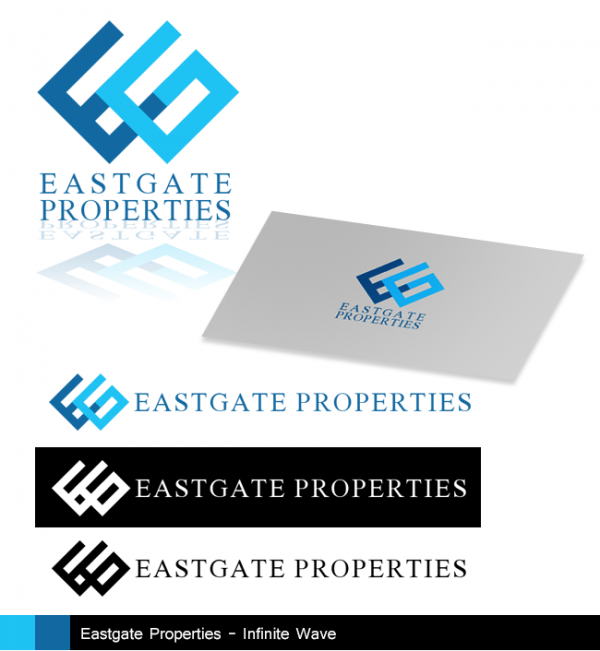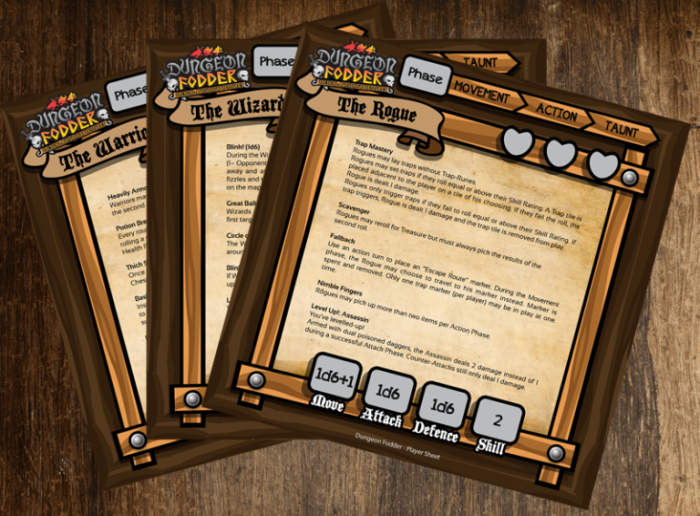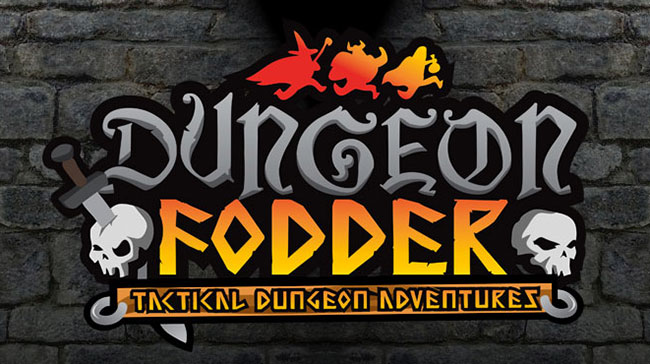Eastgate Properties
Another more serious Corporate Identity for a Property Developer. Infinity and Flowing were important to the design.

It Builds Character
I’ve finally settled on a look for the characters of Dungeon Fodder, namely the Warrior, Wizard and the Rogue. This has actually undergone many changes and I realize part of the problem could be my own perception that any art is never finished and every time you come back to an unfinished piece, there will be a part of you that wants to chuck the entire thing out and start over again.

Well I’ve settled for this look for the characters for a number of reasons;
Thinking back to my past as an animator, if you character has long lasting appeal, then there is a higher chance your game would make it commercially. I also feel these designs would have a higher ‘cute’ rating and would look interesting as potential plushies (how and when is a problem for another day). This was something I picked up while pitching for an animated series a few years back. Merchandising always has to have a place in your project planning. Many artists cringe at the thought of such crass commercial considerations infringing on the artistic process but that’s the way the industry works.
After much thought, I do think there is some truth in that, the problem is where to draw the line.
Borders Stocks European Board-Games
I recently found out that Borders stocks European Board-games. This is an interesting potential and I’d add it to my list of things to check out.

Why making games makes cents
An article I wrote for Areca Capital’s January newsletter on the 26th of December 2013. The focus here is on Digital Games but I think this will be a good lead up to exploring table-top game commercialization as well.
Games are largely misunderstood and are seldom seen as a worthwhile industry to many but this isn’t the case and here’s why. My first statement would be that games are definitely making money. Whether for entertainment, education, training or simulation purposes, games are generating a lot of income. One of the first few games to capitalize on the rise of the mobile gaming industry has been the ever famous Angry Birds by Rovio Entertainment Ltd, a Finnish game developer that launched their game in December 2009 in Apple’s App Store. Angry Birds has since enjoyed nearly 2 billion downloads and has spawned multiple franchises as well as its own merchandise line. At a dollar a download (typical of Apps in the App Store), you get the idea that Rovio’s developers are really happy people indeed.
On the PC games front, we have online games like World of Warcraft (WoW) by the ever popular Blizzard Entertainment. WoW is a massively multiplayer online role-playing game that involves millions of players living in a persistent virtual world. Currently it is still the world’s most-subscribed online game with over seven million subscribers followed only by Eve Online. At its height, WoW boasted over 13 million players worldwide and with a monthly subscription fee of $15, you can imagine how much money Blizzard makes in a year.
A personal favorite, Swedish Indie developers Mojang of Minecraft fame has sold over 33 million copies of their game since its launch in 2009. Their intellectual property has even been licensed to toy-making giants Lego in 2012 and also has its own line of merchandise which includes handbooks, annuals, poster books, magazines, and T-Shirts. Not bad for a small group of developers.
More recently closer to home, Puzzle & Dragons, a mobile puzzle game about collecting digital monsters has been reported to be earning $3.75 million a day! GungHo Online Entertainment, the Japanese studio responsible for Puzzle & Dragons posted a profit of $183 million in the early quarter of 2013. Other successes in the mobile arena would be Supercell’s Clash of Clans that generates $2.4 million per day in the first half of 2013.
The most recent and astounding success story has been the launch of the arguably controversial game Grand Theft Auto V whose sales broke records by earning $800 million in worldwide revenue in the first 24 hours of its release and eventually surpassing $1 billion in sales in the next two days. The game itself took 5 years to develop and industry analysts estimate Take Two’s (the company behind Rockstar Games which developed GTAV) investment in the production of the game at somewhere between $200 million to $265 million.
Hopefully I’ve established that games are great revenue generators but not many developers have successfully decoded what it takes to not only develop but also to market and sell their games. The industry success stories are built upon the numerous bodies of failed endeavors and investors would be wise to be aware of the risks involved. Traversing the business end of games is indeed a tricky and stormy journey at best.
Some games monetize through direct sales, through online distribution portals or retail physical copies. Valve’s Steam and Desura are digital distribution services where gamers can purchase virtual copies of their games which can then be downloaded at their convenience. This is seen to be where the future of most games will be headed with the proliferation of broadband globally. Some games monetize through advertising revenue such as online web game portals like Kongregate or Armor Games where players go through advertisements before allowed access to a host of free-to-play games. The revenue from the advertising is then split between the service provider and the developer.
There are games like previously mentioned World of Warcraft which operate on a subscription basis where players pay a monthly fee to gain full access to the game and its services. While still going strong, this mode of monetization is fast losing popularity with the influx of free-to-play games. Free-to-play games are games which are offered freely without charge but earn revenue off its players purchasing in-game purchases such as cosmetic upgrades or powerups.
Games are also treated as a form of promotion, where companies commission the development of product-specific games to promote their brands or create awareness. More and more advertisers are seeing the interactivity that games provide as more engaging and provides a longer lasting impression for their brands.
These are just the tip of the iceberg and there are many other ways for digital games as a medium to generate income. Having said that, this article isn’t meant to paint a rosy picture about the guarantees or returns that the game industry can provide but it is to make a simple statement that it is an industry worth looking into further as a career or an investment vehicle.
Malaysia is currently an attractive target for many international development studios and companies as we are strategically situated, proficient in English, and our infrastructure has improved vastly. The government has also recognized the potential of developing this sector in its many initiatives to attract foreign direct investments to our shores and also to promote the setting up of our own local development studios to develop homegrown intellectual property. Technology is ever evolving and so is the game development industry, it is this and many other factors that make the development of games a serious and lucrative industry to explore.
Research Progress Report #1
Research Progress Report #1
While initially planning to research into ways of commercializing a board-game of my own devising, I’ve realized that I would need to first explore what has been done and from that, find out what works and what doesn’t. In order to achieve that I am now exploring the potential of Practice-based or practice-led research which based on a guide written by Linda Candy is an “original investigation undertaken in order to gain new knowledge partly by means of practice and the outcomes of that practice.”
I have yet to discuss this in full with my supervisor but I think my next step would be to interview the many table-top game developers in Malaysia and find out how they attempted to commercialize their own board-games and also whether or not those methods were successful or did not achieve their intended goals. Armed with that knowledge, I would like to plan out my own pathway to commercializing my own board-game entitled “Dungeon Fodder” and see if my new approach works.
The few hurdles I foresee would be the means to manufacture as well as sell my board-game. During my research I’ve also come across many websites and services that sell small-order custom board-games by independent developers internationally. This could also be a practical modal that I can emulate or subscribe to in order to self-publish my board-game and document its progress.
Looking forward, I’d be looking into these areas as I conduct my research (through Interviews) with various parties such as table-top developers, board-game communities, manufacturers, retailers and also businesses.
Research Areas
Inspiration – How and why develop board-games as opposed to other mediums
Prototyping & Testing – Their process of prototyping and testing and documenting the results
Funding Projects – How did they fund their projects?
Manufacturing – How did they approach manufacturing?
Self-Publishing vs Publishing – Their opinions on the benefits and cons of both methods.
Copyright, Patents & Protection – How did they go about protecting their Intellectual Property.
Social Media & Marketing – How did they market their products.
Board-game Festivals – Alternate ways of bringing board-games to the international arena.
Ruleset Draft 1
My rulesets are finally done (first draft anyways) and I just realized how much more work there is to do. Both on the research side as well as the product development side.

Just wanted to add for the record that my main supervisor is Dr. Tan Wee Hoe and my secondary supervisor is Dr. (Ing) Maizatul Hayati bt. Mohamad Yatim (maizatul@fskik.upsi.edu.my) in case I ever lose my contacts. This journal is my online stash of information.
Interview – Ooi Leng Hang
Today’s interview went off pretty well as I met up with Mr. Ooi Leng Hang who is the Election Bureau Executive Director of the Democratic Action Party. As for why I am meeting a member of the opposition party, it is because of the board-game adaptation of Monopoly that they made to highlight their objectives and create awareness of some of the current ruling government’s shortfalls. It was named Monopoli which wasn’t too creative but they are very willing to draw similarities to that other board-game which it drew inspiration from.
As I did not have my recording device with me, I’ll be paraphrasing;
What is your background?
A student of Fine Arts from the Kuala Lumpur Art Center, Mr. Ooi is the illustrator behind the DAP’s hornbill mascot ‘Ubah’. He currently handles a lot of their promotional material and media projects.
Are you a board-gamer?Not really, he plays or have played the usual (common) board-games such as Monopoly but has not gotten into the whole Euro-Boardgame trend.
Do you play Digital Games?
Not really as well, he plays games on his mobile device but not really on a PC. He quotes Candycrush as a game he has been playing for the past 6 months.
What is Monopoli’s objective?
To teach others about politics especially what is happening locally. The game highlights plenty of scandals and each player is given C4 to use in the game. The game was also used a a means of fund collecting but that was not its primary objective. Using games also makes it more accessible to today’s youth who might previously have not shown any interest in politics or the governance of their country.
How long did it take to make Monopoli?
About a year, from conceptualization. The actual production was faster but the idea remained an idea for quite some time until the general elections neared.
How did you do your testing?
They tested it out amongst their colleagues and friends. The final version of the game underwent rebalancing and does not resemble the earliest prototype.
What was the response?Very positive with them selling quite a number of units. Currently the game is no longer in production. (Number of units sold is withheld from this journal)
Price?
Ooi was unsure but other news articles priced the game at RM5. The game was not meant to generate income but as a more effective and fun brochure.
Future plans or possible commercialization?
There are no current plans for Monopoli but they’ve been approached by developers interested in converting the game to an application for the iOS. Interest in that project has died down somewhat but they are open to explore the possibility.
End of interview.
Research Topic Redefinition
Before the redefinition class, my topic was “The Commercialization of Table-top Games in Malaysia” which was broad enough a topic to allow for much exploration yet I’ve scoped it down to focus on Malaysia which is basically where I have the most access and connections thus making it easier to realize.
After the class on redefining my research topic with Dr. Tan however, it might be prudent to revisit this and really think this through. According to my colleague Hilmy, my topic could actually be broken down further and a part of it was actually the content for a PhD research (if I ever get there).
The initial plan was to
- Study existing methods of commercialization employed by the many companies I know of, analyze their results and identify their problems or strengths.
- Look at their model through areas such as Conceptualization, Prototyping, Testing & Iteration, Funding, Manufacturing and Publishing.
- Study the current retail landscape within Malaysia.
- Come up with a way to actually lay the groundwork for the commercialization of future tabletop games.
- Test the new model with my own board-game Dungeon Fodder.
- Report the findings and graduate.
It seems though that for a Master’s level of research, articles 1 through 3 would actually suffice. Article 4 & 5 could be a more focused and pretty large area to explore for a PhD instead. I’ve got to run this through my supervisor but in that case I think it would definitely make this easier to separate and execute.
According to Dr. Noraini Idris, quoted by Dr. Tan, a research title should be
- Specific in nature
- Reflect fundamental issues to be resolved
- Novelty
- Preferably 12 – 15 words long. (I can attest to this as I’ve seen some rather long gibberish)
More to come on redefinition
Tomes of Academia
There are many resources available to researchers and its going to be a long and arduous journey sifting through to find relevant research papers. There is a large difference between citing academic journals and citing internet sources or books. Academic journals have been peer reviewed by others in academic while most of my current sources are from websites and other non-academic sources. This is going to be one of my largest weaknesses which is the lack of a formal proper academic background. I’ve never had to do a dissertation so far and a 25,000 word thesis is going to be a massive pain.
Well, one of the recommended academic journal databases recommended by my supervisor was Ethos, http://ethos.bl.uk.
Thankfully KDU library also subscribes to a large number of databases so my next step is to start collecting literature to better understand my topic and redefine it.

Also here is the finalized version of my logo. It should be less serious, while also impressing upon those that like Role-playing games and the fantasy genre that it is a light-hearted take on adventuring in a dungeon. I’ve also added the three ‘flee’ing characters above to represent the three playable classes in the game.
Digging up Dungeons
Rejuvenating an old project for a research project brought back many memories. Time to start cracking at it.
I’ve got about 2 weeks to begin testing phases.


